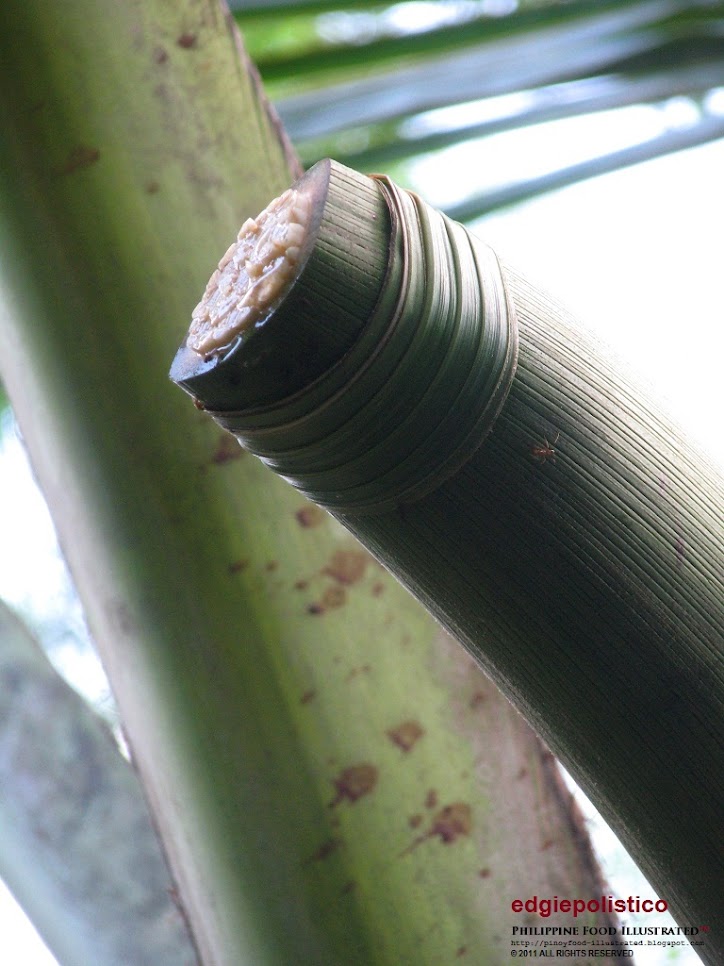
A miracle fruit tree on the roadside of Brgy. Mambago, Sta. Rosa, Babak, Island Garden City of Samal (IGACOS) in Samal island, Davao del sur.
miracle fruit - (Mindanao fruit) [n.] calabash (sc.name: Crescentia cujete).
Miracle fruit (Calabash) is used to be known only in Mindanao. It was seen growing anywhere there (in red). Latest distribution inventory shows miracle fruit is now all over the Philippines. I marked the provinces and islands in orange labels where miracle fruit is now grown and distributed by locals.
Miracle
fruit (internationally known as the calabash) is a tree that bears huge fruits that looks like a buko (young coconut). It grows abundantly everywhere in Mindanao, some parts
of the Bicol region, and in the Visayas. Few are also growing in Luzon up to
the northern part of Ilocos and Cagayan region (see the food map, above, for the latest inventory).

At first glance, you could have mistaken this as a young coconut fruit growing on a small tree.
Sadly, most of the fallen fruits were left to rot on the ground. Most local folks do not know what to do to make good use of this wonderful
fruit. They dreaded the black color of its flesh and the gummy smell. What they do not realize is that black juice is sweet and has
healing wonders, the reason why old folks called it the "miracle fruit."
I tried one. And yes, it was wonderful.

The outer shell is very hard that you have to cut it with a saw to split open into halves You cannot just cut the calabash fruit with a knife, unless you use a big bolo or machete.

Many
who tried this drink claimed they experienced rejuvenating vigor
and mental alertness. It is good when you are going to study, review,
or take an exam.
Local women who have tried the freshly extracted black juice claimed it helped ease their menstrual pain.
Good for those who are recuperating from sickness and a treat
after a weary activity.

The flesh is white, moist, and soft.

I
experimented with the first calabash fruit I got from Mindanao. I extracted the juice and processed my first miracle fruit wine at home. I hand-carried one fresh green fruit of calabash on my
flight from Misamis Oriental to Metro Manila. I cut open and processed the
fruit juice into miracle fruit wine using the needed ingredients that were found in the groceries. After three months of
fermentation, I had the wine and enjoyed it.
I
wonder if this fruit once grew in the fountain of youth. The vigor made me feel younger. Next time, I will no longer bring a
calabash fruit. I will bring the tree.

When boiled, the flesh of calabash turns black.

Here's a calabash fruit I found in Cagayan de oro City, Misamis Oriental in Mindanao. I brought it home in Metro Manila. Cooked it into tea and later processed into wine.
How to know if the miracle fruit is already ripe to harvest:
- The color of the fruit is dark green and has slight shades and spots of brown.
- The surface or outer skin is no longer shiny.
- It is heavier and sounds dull when you knock it with your fingers.
Personal Notes
Miracle fruit (Calabash) is used to be known only in Mindanao. It was seen growing anywhere there (shaded red in the food map, above). The latest distribution inventory shows miracle fruit is now all over the Philippines. I marked the provinces and islands in orange labels where miracle fruit is now grown and distributed by locals.
I first saw this fruit and the tree on the campus of Notre Dame University, Cotabato City on November 10, 2010. Since then, I took notes on where else I found miracle fruit in Mindanao.
In 2017, I picked a fruit from a tree in Cagayan de Oro and hand-carried it on my flight back to Manila where I tried to process it into wine. The wine turned out good - it tastes jammy and fruity. I kept a bottle of it until now for aging.
Related readings:
- Calabash the miracle fruit, Henrylito D. Tacio, Business Mirror, Oct. 15, 2015, https://businessmirror.com.ph/2015/10/15/calabash-the-miracle-fruit/
- Calabash Tree (Crescentia cujete Linn.), Dr. Godofredo Stuart, Stuart Xchange, http://www.stuartxchange.org/Cujete
If you liked this post and our site, share it.
Let us know your opinion on the subject. Feel free to comment in the comment section, below. It is important for us to know what you think.
Tell us what other topics you would like us to write, share, and discuss.
Related posts:




Continue to follow my blogs. You can also follow and learn more by joining us in our Facebook group. Have more bits and pieces about our kind of food, ingredients, and ways of cooking, dining, and knowing food culture across the 7,641 islands of the Philippines.
Thank you for all the encouragement and enthusiasm. I need your moral support, prayers, and what else that can uplift my spirit and keep my good reasons. Keep them coming.
Sharing is happiness to me. If you are pleased and happy of what you found here, please share the happiness we have in the PHILIPPINE FOOD ILLUSTRATED. I feel energized when it becomes part of the reasons why you are happy and smiling.
Edgie Polistico
For more abou
t Filipino food, see this Philippine Food, Cooking, and Dining Dictionary. It is OPEN and FREE.


%20Mambago%20StaRosa,%20Babak,%20Samal%20island,%20Davao%20del%20sur%20by%20Edgie%20Polistico%20watermarked2.jpg)



.JPG&container=blogger&gadget=a&rewriteMime=image%2F*)
.JPG&container=blogger&gadget=a&rewriteMime=image%2F*)
.JPG&container=blogger&gadget=a&rewriteMime=image%2F*)
.JPG)



%20by%20Edgie%20Polistico.png)
.JPG)
.JPG)

















